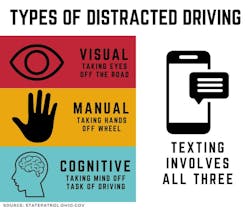Distracted driving kills thousands of people on U.S. highways annually. In 2022, 3,308 people were killed in motor vehicle crashes involving distracted drivers, according to the latest data from the National Highway Traffic Safety Administration. When drivers engage in any activity that diverts their attention, it can create problems for them and anyone they share the road with.
What are the types of distracted driving?
According to the Centers for Disease Control and Prevention, distracted driving can be divided into three categories:
- Cognitive: Taking your mind off driving
- Manual: Taking your hand(s) off the steering wheel
- Visual: Taking your eyes off the road
Acts of distracted driving can include using a cellphone or GPS device, being tired, eating, adjusting the radio or other vehicle settings, smoking, driving under the influence of drugs or alcohol, and more.
The most dangerous forms of distracted driving are those that fit into more than one category. Cellphone use is so dangerous because it distracts drivers manually by taking one or both hands off the wheel, visually by moving eyesight from the road to the phone, and cognitively because drivers become mentally focused on their phone rather than the road.
What are the misconceptions about distracted driving?
I can multitask
In a distracted driving panel, Steve Bojan, director of transportation safety and loss control services at insurance provider Sentry, emphasized why multitasking while driving is such a problem.
“When we talk about distracted driving, and on the cognitive side in particular, it's important to remember our mind is geared to do one thing at a time,” he said. “We always talk about multitasking, but that's a myth. Our brain is wired to do one thing at a time; the more things we're doing, the less attention we have to others ... And as we're moving at higher speeds, oftentimes on the highway—60, 70, sometimes 80 miles an hour in certain parts of the country—there's very little room for error.”
Hands-free technology is safe
In the same panel, Thomas Goeltz, SVP and director of risk management services at Brown & Brown and distracted driving victims advocate with the National Safety Council, claimed that drivers are still cognitively distracted when using hands-free technology, like talking on speaker or through Bluetooth, and that cognitive distraction causes 85% of distracted driving crashes and fatalities.
John O’Grady, corporate safety services specialist at Sentry, explained that it can take years to get laws passed by state governments, so it’s not safe to assume that using hands-free technology is safe just because it’s legal. Both said transportation companies should impose stricter policies regarding cellphone use while driving than those currently allowed by state governments.
How distracted drivers impact trucking
While distracted truck drivers are a problem, another big problem for the trucking industry is sharing the road with distracted unprofessional drivers. In a previous FleetOwner article from July, Ryan McMahon, SVP of strategy for Cambridge Mobile Telematics, best explained how other distracted drivers can be such a problem for truck drivers.
“For a truck driver, the more distraction that's around them, the higher the hazard is for them,” McMahon said. “And it's much worse for drivers of large vehicles because the vehicles don't have the same responsiveness that other vehicles do. If somebody drifts into the lane and [truck drivers] need to make an emergency braking activity, that could have disastrous consequences. So, the consequences for truck drivers are much worse for people around them, and they take the brunt of it. Anytime a truck is involved in a crash, it becomes a much more serious issue than just any normal crash.”
To deal with other distracted drivers, truck drivers must remain vigilant and practice defensive driving; they cannot be distracted themselves.
See also: These states have the most distracted professional drivers
How truck drivers can be distracted
However, truck drivers can also be distracted, and this distraction often looks different for professional drivers versus unprofessional drivers.
Some distractions experienced by truck drivers tend to be more specific. According to The Law Firm for Truck Safety, these include communication with dispatch, in-cab technology, daydreaming, paperwork, physical maps, and more.
Truck drivers may also be more prone to drowsy driving due to spending more hours on the road than a typical driver and sometimes late into the night. Even if drivers are only beginning to feel tired, their driving can be more affected than they would think. The National Safety Council reports that drivers are three times more likely to be in a crash if they are fatigued, and according to the AAA Foundation for Traffic Safety, more than 17% of all fatal crashes involve a drowsy driver.
What are the solutions to distracted driving?
The trucking industry and other entities have sought distracted driving solutions for years. While distraction can’t be eradicated entirely, here are the solutions championed so far:
Technology
Fleets are using technology to help prevent drivers from driving while distracted or drowsy. This technology includes sensors, cameras in and out of the cab, artificial intelligence, and more. Samsara and Netradyne are just a few companies rolling out this technology to fleets. Many of these technology offerings can detect when drivers are falling asleep or being distracted by their phones, and then send alerts to the drivers and/or fleet managers for training purposes.
Safety culture
Insurance provider Travelers’ 2024 Travelers Risk Index shows that business leaders are concerned about their employees driving while distracted, but not all have implemented company policies.
A previous FleetOwner article quoted a panel on distracted driving hosted by insurance provider Sentry. During the panel, experts emphasized the importance of creating and enforcing fleet policies across the board.
“The first key is everybody has to follow the same rules of the organization from the president and CEO down to the driver down to the admin that goes to the post office three times a week to pick up the mail,” said Steve Bojan, director of transportation safety and loss control services at Sentry. “Everybody has to be following the same rule, and you have to have the same enforcement mechanism for all of them. Otherwise, it's not going to work if we watch the district manager leave, and they're on their phone, holding it up to their head as they're leaving the gate for the facility. What does that tell everybody else?”
Brown & Brown's Goeltz backed up this point, emphasizing that transportation leaders can’t implement these policies and then call their drivers while they’re on the road.
Regulations
Since 2000, lawmakers have been concerned about distracted driving caused by cellphone use. Today, 30 states have hands-free laws that make it illegal for drivers to use their phones while behind the wheel. The most recent states that enacted hands-free laws are Michigan, Ohio, Alabama, and Missouri.
According to the Government Highway Safety Association, phone use while driving is a primary offense in all 30 of these states except Alabama and Missouri. This means that in most states, a driver can be pulled over for holding a phone while driving. In Alabama and Missouri, drivers have to commit another offense to be pulled over, but then breaking a hands-free law can be added as a secondary offense.







